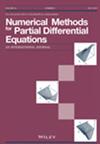基于 voronoi 的列选择的最优性
IF 1.7
3区 数学
Q1 MATHEMATICS, APPLIED
引用次数: 0
摘要
虽然有一系列丰富的矩阵列子集选择问题(CSSP)算法可用于内插法和 CUR 型分解,但随着输入矩阵的增大,这些算法的使用往往会变得令人望而却步。为了解决这些问题,我们在早期的工作中开发了一个通用框架,将列分割例程与列选择算法配对使用。在该工作中提出的四种算法中,有两种将中心伏罗诺正交分解法(CVOD;Centroidal Voronoi Tessellation Based Proper Orthogonal Decomposition Analysis,2003,137-150)和自适应变体(adaptCVOD)与离散经验插值法(DEIM;SIAM J. Sci. Computer.38 (2016), no.3,A1454-A1482)。在这项工作中,我们扩展了这一框架,并将 CVOD 类型算法与任何返回线性独立列的 CSSP 算法配对。我们的结果包括这些配对算法所提供解的详细误差边界,以及明确描述所选列分割质量如何影响 CSSP 解的表达式。除了涉及矩阵逼近的示例外,我们还在模型阶次缩减 (MOR) 中经常遇到的任务上测试了我们的几种基于分区的构造。本文章由计算机程序翻译,如有差异,请以英文原文为准。
On the optimality of voronoi‐based column selection
While there exists a rich array of matrix column subset selection problem (CSSP) algorithms for use with interpolative and CUR‐type decompositions, their use can often become prohibitive as the size of the input matrix increases. In an effort to address these issues, in earlier work we developed a general framework that pairs a column‐partitioning routine with a column‐selection algorithm. Two of the four algorithms presented in that work paired the Centroidal Voronoi Orthogonal Decomposition (CVOD ; Centroidal Voronoi Tessellation Based Proper Orthogonal Decomposition Analysis , 2003, 137–150) and an adaptive variant (adaptCVOD ) with the Discrete Empirical Interpolation Method (DEIM; SIAM J. Sci. Computer . 38 (2016), no. 3, A1454–A1482 ). In this work, we extend this framework and pair the CVOD ‐type algorithms with any CSSP algorithm that returns linearly independent columns. Our results include detailed error bounds for the solutions provided by these paired algorithms, as well as expressions that explicitly characterize how the quality of the selected column partition affects the resulting CSSP solution. In addition to examples involving matrix approximation, we test several of our partition‐based constructions on tasks commonly encountered in model order reduction (MOR).
求助全文
通过发布文献求助,成功后即可免费获取论文全文。
去求助
来源期刊
CiteScore
7.20
自引率
2.60%
发文量
81
审稿时长
9 months
期刊介绍:
An international journal that aims to cover research into the development and analysis of new methods for the numerical solution of partial differential equations, it is intended that it be readily readable by and directed to a broad spectrum of researchers into numerical methods for partial differential equations throughout science and engineering. The numerical methods and techniques themselves are emphasized rather than the specific applications. The Journal seeks to be interdisciplinary, while retaining the common thread of applied numerical analysis.

 求助内容:
求助内容: 应助结果提醒方式:
应助结果提醒方式:


